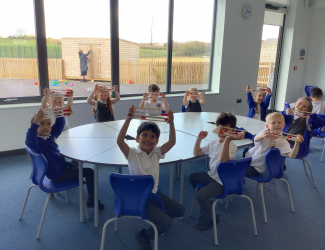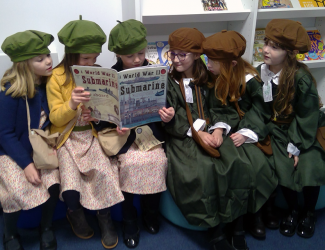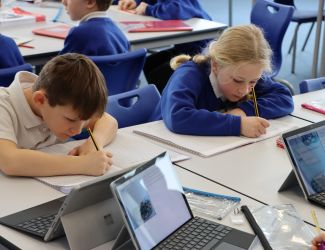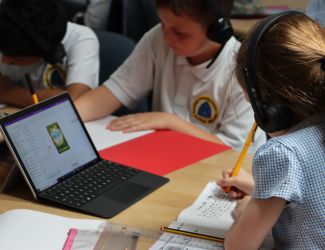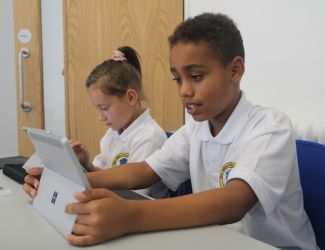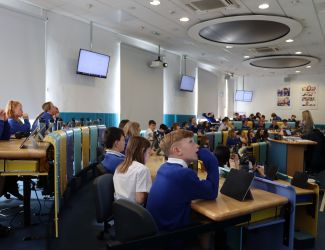Year 2 Maths Curriculum
Children will be taught all strands of maths; Number and Place Value, Addition and Subtraction, Multiplication and Division, Fractions, Algebra, Measurement, Properties of Shape, Position and Direction and Statistics. Within this they will be taught a range of mathematical skills as well as real life maths and investigative maths where the children apply their mathematical learning in a range of contexts and situations.
Number and Place Value
- Count in steps of 2, 3, and 5 from 0, and in tens from any number, forward or backward
- Compare and order numbers from 0 up to 100; use <, > and = signs
- Identify, represent and estimate numbers using different representations, including the number line
- Read and write numbers to at least 100 in numerals and in words
- Recognise the place value of each digit in a two-digit number (tens, ones)
- Describe and extend simple number sequences including odd and even numbers and counting on and back in steps of 1s, 2s, 3s, 5s, 10s and from any 2-digit number
Addition and Subtraction
- Recall and use addition and subtraction facts to 20 fluently, and derive and use related facts up to 100
-
Add and subtract numbers using concrete objects, pictorial representations, and mentally, including:
- Lengths and heights [e.g. long/short, longer/shorter, tall/short, double/half]
- Mass/weight [e.g. heavy/light, heavier than, lighter than]
- Capacity and volume [e.g. full/empty, more than, less than, half, half full, quarter]
- Time [e.g. quicker, slower, earlier, later]
- Recognise and use the inverse relationship between addition and subtraction and use this to check calculations and solve missing number problems.
-
Solve problems with addition and subtraction:
- Using concrete objects and pictorial representations, including those involving numbers, quantities and measures
- Applying their increasing knowledge of mental and written methods
- Solve simple problems in a practical context involving addition and subtraction of money of the same unit, including giving change (copied from Measurement)
Multiplication and Division
- Count in steps of 2, 3, and 5 from 0, and in tens from any number, forward or backward (copied from Number and Place Value)
- Recall and use multiplication and division facts for the 2, 5 and 10 multiplication tables, including recognising odd and even numbers
- Show that multiplication of two numbers can be done in any order (commutative) and division of one number by another cannot
- Calculate mathematical statements for multiplication and division within the multiplication tables and write them using the multiplication (×), division (÷) and equals (=) signs
- Solve problems involving multiplication and division, using materials, arrays, repeated addition, mental methods, and multiplication and division facts, including problems in contexts
Fractions (including Decimals and Percentages)
- Pupils should count in fractions up to 10, starting from any number and using the1/2 and 2/4 equivalence on the number line (Non Statutory Guidance)
- Recognise, find, name and write fractions 1/3, 1/4, 2/4 and 3/4 of a length, shape, set of objects or quantity
- write simple fractions e.g. 1/2 of 6 = 3 and recognise the equivalence of 2/4 and 1/2.
Algebra
- Recognise and use the inverse relationship between addition and subtraction and use this to check calculations and missing number problems. (copied from Addition and Subtraction)
- Recall and use addition and subtraction facts to 20 fluently, and derive and use related facts up to 100(copied from Addition and Subtraction)
- Compare and sequence intervals of time (copied from Measurement)
- Order and arrange combinations of mathematical objects in patterns (copied from Geometry: position and direction)
Measurement
- Compare and order lengths, mass, volume/capacity and record the results using >, < and =
- Compare and sequence intervals of time
- Choose and use appropriate standard units to estimate and measure length/height in any direction (m/cm); mass (kg/g); temperature (°C); capacity (litres/ml) to the nearest appropriate unit, using rulers, scales, thermometers and measuring vessels
- Recognise and use symbols for pounds (£) and pence (p); combine amounts to make a particular value
- Find different combinations of coins that equal the same amounts of money
- Solve simple problems in a practical context involving addition and subtraction of money of the same unit, including giving change
- Tell and write the time to five minutes, including quarter past/to the hour and draw the hands on a clock face to show these times.
- Know the number of minutes in an hour and the number of hours in a day. (appears also in Converting)
- Know the number of minutes in an hour and the number of hours in a day. (appears also in Telling the Time)
Properties of Shapes
- Identify and describe the properties of 2-D shapes, including the number of sides and line symmetry in a vertical line
- Identify and describe the properties of 3-D shapes, including the number of edges, vertices and faces
- Identify 2-D shapes on the surface of 3-D shapes, [for example, a circle on a cylinder and a triangle on a pyramid]
- compare and sort common 2-D and 3-D shapes and everyday objects
Position and Direction
- Use mathematical vocabulary to describe position, direction and movement including movement in a straight line and distinguishing between rotation as a turn and in terms of right angles for quarter, half and three-quarter turns (clockwise and anti-clockwise)
- Order and arrange combinations of mathematical objects in patterns and sequences
Statistics
- Interpret and construct simple pictograms, tally charts, block diagrams and simple tables
- Ask and answer simple questions by counting the number of objects in each category and sorting the categories by quantity
- Ask and answer questions about totalling and comparing categorical data

